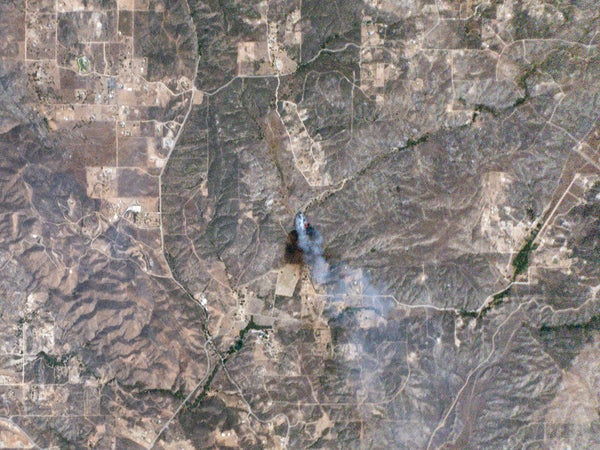This article was published in Scientific American’s former blog network and reflects the views of the author, not necessarily those of Scientific American
Space exploration or humanitarianism? This was the choice I was torn between my first year at the University of North Carolina at Chapel Hill. I was active in both SEDS (Students for the Exploration and Development of Space), a student-led group to explore space, and STAND, a student-led group to end mass atrocities. While drawn to space because of the limitless unanswered questions it posed, I questioned how I could warrant spending time in an observatory when I could be spending time on humanitarian efforts that directly and immediately help people.
On the morning of October 22, 2011, those questions were answered. I listened to a data scientist from the Harvard Humanitarian Initiative deliver a lecture on using satellite imagery to identify mass atrocities. Using imagery from DigitalGlobe, the Initiative had found visual evidence of mass graves in South Kordofan, Sudan that were consistent with reports of mass killings in the region. The imagery also revealed evidence of the intentional burning of the Blue Nile, Sudan village of ‘Amara by the Sudan Armed Forces. The satellite imagery corroborated eyewitness reports from locals and enabled reporters and humanitarian organizations to provide evidence of these crimes to the international community.
That same year, Planet Labs, a San Francisco-based space startup, was born in the garage of the Bay Area’s Rainbow Mansion with the mission of using space to help life on Earth. Planet Labs recognized that the high cost and low cadence of existing government and commercial Earth-imaging platforms made them insufficient for detecting change—be it in in villages, forests, or economies—on our planet on a timescale required to detect many problems. These spacecraft were so large and expensive that we could operate just a few at any given time, taking months or even years to acquire a complete picture of our planet.
On supporting science journalism
If you're enjoying this article, consider supporting our award-winning journalism by subscribing. By purchasing a subscription you are helping to ensure the future of impactful stories about the discoveries and ideas shaping our world today.
Planet Labs aimed to create Earth-imaging spacecraft—called ‘doves’ as a symbol of their peaceful mission—that are a fraction of the size and cost of any other Earth-imaging spacecraft. They are succeeding. With access to this high-cadence data, the Amazon Conservation Association was able to prove the perpetration of illegal gold mining in Southern Peru in images spanning just three months, from January 2016 to March 2016, hardly a month after the images had been collected. With their constellation of dove satellites, Planet Labs captured imagery of the Sabina forest fire in 2014 just ten minutes after the fire was reported, helping to estimate the spread and extent of the fire.
Descartes Labs, a startup spun off from Los Alamos National Laboratory, is using the influx of data from Planet Labs and other Earth imagery providers to predict corn crop yields faster and more accurately than previously possible by the USDA at a resolution of 1/500th of an acre. San Francisco startup Space Know is synthesizing thousands of images from these imagery companies to provide an objective means of assessing the health of manufacturing in China’s economy. This Earth data deluge is also being used by startup Orbital Insight to monitor global and local changes in surface water at a timescale on the order of weeks to understand the intensity of the drought in California and other parched regions.
Earth imagery isn’t the only way companies are using space to help solve global challenges. In the modern world, communication and information access has become a basic human need that is currently inaccessible to half of the world’s population. OneWeb was founded in 2014 to solve this problem, designing a constellation of 648 low-cost small satellites to provide complete Wi-Fi, 3G, and LTE coverage for the entire planet. They have raised an initial $500 million from investors including Coca-Cola, Virgin, and Airbus to begin launching their satellites and building ground terminals in 2018. They plan to have a fully operational fleet providing access to rural and underdeveloped areas by 2020.
Container vessels move 90 percent of global trade each year, but we can’t accurately track the vessels’ AIS (Automatic Identification System) signals through much of its journey using ground-based receivers due to the curvature of the Earth. Spire is using AIS receivers on low-cost satellites to provide global coverage for ship tracking impossible before. Not only does this provide companies with near real-time positioning of their vessels and goods, it also enables governments to detect illegal fishing and shipping piracy. Spire also uses their satellites to perform GPS radio occultation for improving weather forecasting—measuring how signals from GPS satellites in higher orbits have been impacted by varying conditions in Earth’s atmosphere.
Space, more affordable and accessible now than ever before, is becoming an increasingly important tool in our efforts to sustain Earth. It was hard to predict how the personal computer would affect people’s lives even though mainframes had been around for a while. Before consumer aircraft, when airplanes were prohibitively expensive and inaccessible, we never imagined that they’d play critical roles in agricultural activity like dusting and fertilizing crops. As the space industry undergoes its own transformation, companies should be looking for creative applications of space technology to solve challenges on Earth, such as farming in desert regions, providing access to drinkable water, and utilizing alternative energy sources. We must explore space to sustain Earth.
